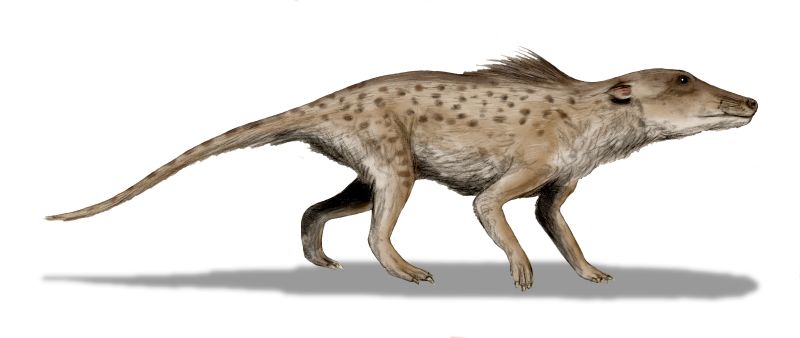![]() Paleontologists have found a new fossil of a whale ancestor - and its announced just after I finish watching my preview DVD of Nat Geo's Morphed on whale evolution. I smell fate.
Paleontologists have found a new fossil of a whale ancestor - and its announced just after I finish watching my preview DVD of Nat Geo's Morphed on whale evolution. I smell fate.

Anyhow, the new whale predecessor was unveiled in a PLoS One article this week. Donned "Maiacetus inuus", the species is described from two adult fossil finds, and reveals even more about whales evolved.
Maiacetus inuus is a new species of Protocetid whale, roughly 2.6 m long and dated to be about 47.5 million years old. Like other Protocetids, Maiacetus' limbs are relatively short and pelvic girdles provide a direct connection to the vertebral column...
Ok, I know, I might as well be speaking gibberish. Let's go back a step.
 Whales, once upon a time, began as land mammals. The earliest definitive ancestor is Pakicetus, which, if you look at the image, really looks nothing like a whale at all. It more closely resembles some small hyena-like creature, though it's got hoofed feet like an ungulate, making more like some carnivorous antelope. The only thing, in fact, which makes it a "whale" is its ears - there's a bone that's only found in the Cetaceans (whales - you'll get it).
Whales, once upon a time, began as land mammals. The earliest definitive ancestor is Pakicetus, which, if you look at the image, really looks nothing like a whale at all. It more closely resembles some small hyena-like creature, though it's got hoofed feet like an ungulate, making more like some carnivorous antelope. The only thing, in fact, which makes it a "whale" is its ears - there's a bone that's only found in the Cetaceans (whales - you'll get it).
This small, meat-eating wolf-cow somehow (technically, there's a bit of an argument on this) led to a group of animals known as the Ambulocetids and Remingtonocetids. These were much more like modern otters - they were clearly semi-aquatic, but also definitely relied on freshwater and land. Their nasal openings are on the top of the snout, like in land mammals, they had legs adapted for swimming, and bone tests of one fossil find, the crocodile-looking Ambulocetus, found residues distinctive of fresh water, meaning they hadn't yet moved into the oceans.
 Finally we get to the Protocetids. The protocetids were more aquatic than their predecessors, finally marine, though they still utilized the land. It's in this group where the hind legs begin to dwindle, that they develop underwater hearing, some begin to have tail flukes, and generally start looking more like whales by the end (like Protocetus, on the left). They still have limbs that, while good for swimming, are able to bear weight. And we arrive at Maiacetus - somewhere in the middle of the Protocetids.
Finally we get to the Protocetids. The protocetids were more aquatic than their predecessors, finally marine, though they still utilized the land. It's in this group where the hind legs begin to dwindle, that they develop underwater hearing, some begin to have tail flukes, and generally start looking more like whales by the end (like Protocetus, on the left). They still have limbs that, while good for swimming, are able to bear weight. And we arrive at Maiacetus - somewhere in the middle of the Protocetids.
In the case of Maiacetus, the proportions of the limbs and long 'fingers and toes' would have made it clumsy on land, much like a seal, so it was probably mostly aquatic. The male had 20% larger canines than the female. Large canines are usually found in male mammals that use these teeth for threat displays and fighting, so it's possible that these were used like that, though little is known about mating behavior even in living marine mammals, and the size difference between the female and male was small, so they could have lived in mixed-sex groups. The most iteresting part, though, isn't the two adult skeletons that were found. The female was pregnant. The baby's skeleton is still inside its mother's!
The fetus was well-developed and looked much like its mother and had a full set of teeth, meaning it was likely "precocious", or relatively mature and mobile from the moment of birth, like modern baby dolphins and whales. It is positioned head downward, like a human baby. There's only one problem with that - in living cetaceans, all babies are born tail first, not head first. This works well in aquatic species, because it makes sure that the baby doesn't try to take a breath before its mother can get it to the surface. So the head down posture of the fetus suggests that Maiacetus gave birth on land, not in the water.
This means that at one point during their evolution, whales may have filled a niche similar to modern seals and sea lions. Or, perhaps, that one day modern seals and sea lions might become fully aquatic. Anyhow, finding a pregnant fossil is an incredibly rare and lucky find, and in my opinion, awesome one. Be sure to check out the article - it's got some great images and some really interesting information. I swear, I need to become a paleontologist!
Philip D. Gingerich, Munir ul-Haq, Wighart von Koenigswald, William J. Sanders, B. Holly Smith, Iyad S. Zalmout (2009). New Protocetid Whale from the Middle Eocene of Pakistan: Birth on Land, Precocial Development, and Sexual Dimorphism PLoS ONE, 4 (2) DOI: 10.1371/journal.pone.0004366
- Log in to post comments
